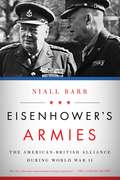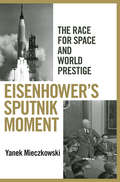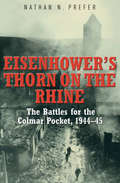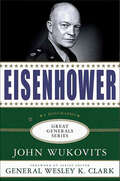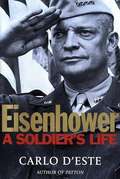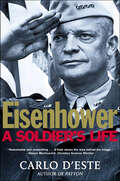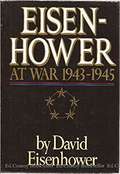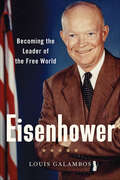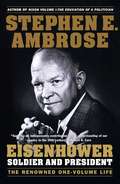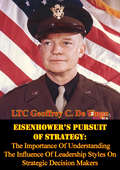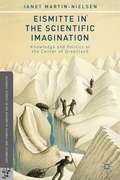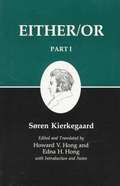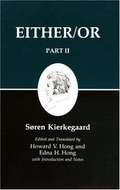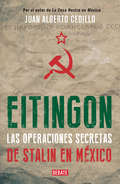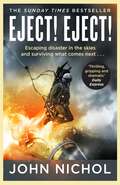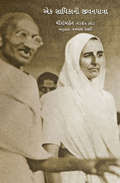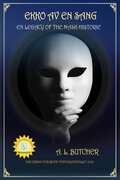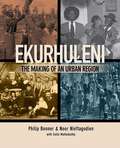- Table View
- List View
Eisenhower vs. Warren: The Battle For Civil Rights And Liberties
by James F. SimonThe epic 1950s battle that would shape the legal future of the civil rights movement is chronicled here for the first time. The bitter feud between President Dwight D. Eisenhower and Chief Justice Earl Warren framed the tumultuous future of the modern civil rights movement. Eisenhower was a gradualist who wanted to coax white Americans in the South into eventually accepting integration, while Warren, author of the Supreme Court’s historic unanimous opinion in Brown v. Board of Education, demanded immediate action to dismantle the segregation of the public school system. In Eisenhower vs. Warren, two-time New York Times Notable Book author James F. Simon examines the years of strife between them that led Eisenhower to say that his biggest mistake as president was appointing that “dumb son of a bitch Earl Warren.” This momentous, poisonous relationship is presented here at last in one volume. Compellingly written, Eisenhower vs. Warren brings to vivid life the clash that continues to reverberate in political and constitutional debates today.
Eisenhower's Armies: The American-British Alliance during World War II
by Niall BarrAn authoritative and dramatic behind-the-scenes history of 'the Atlantic Alliance' during World War II. The Anglo-American relationship from 1941-1945 proved to be the most effective military alliance in history. Yet there were also constant tensions and disagreements that threatened to pull the alliance apart. This book highlights why the unprecedented level of cooperation between the very different American and British forces eventually led to victory but also emphasizes the tensions and controversies which inevitably arose. Based on considerable archival research on both sides of the Atlantic, this work considers the breadth and depth of the relationship from high-level strategic decisions, the rivalries and personalities of the commanders to the ordinary British and American soldiers who fought alongside one another. The book also looks back and demonstrates how the legacy of previous experience shaped the decisions of the war. Eisenhower's Armies is the story of two very different armies learning to live, work, and fight together even in the face of serious strategic disagreements. The book is also a very human story about the efforts of many individuals—famous or otherwise—who worked and argued together to defeat Hitler’s Germany. In highlighting the cooperation, tensions, and disagreements inherent in this military alliance, this work shows that Allied victory was far from pre-ordained and proves that the business of making this alliance work was vital for eventual success. Thus this dynamic new history provides a fresh perspective on many of the controversies and critical strategic decisions of World War II. As such, this book provides expert analysis of the Anglo-American military alliance as well as new insights into the ‘special relationship’ of the mid-twentieth century.
Eisenhower's Sputnik Moment: The Race for Space and World Prestige
by Yanek MieczkowskiIn a critical Cold War moment, Dwight D. Eisenhower's presidency suddenly changed when the Soviet Union launched Sputnik, the world's first satellite. What Ike called "a small ball" became a source of Russian pride and propaganda, and it wounded him politically, as critics charged that he responded sluggishly to the challenge of space exploration. Yet Eisenhower refused to panic after Sputnik-and he did more than just stay calm. He helped to guide the United States into the Space Age, even though Americans have given greater credit to John F. Kennedy for that achievement.In Eisenhower's Sputnik Moment, Yanek Mieczkowski examines the early history of America's space program, reassessing Eisenhower's leadership. He details how Eisenhower approved breakthrough satellites, supported a new civilian space agency, signed a landmark science education law, and fostered improved relations with scientists. These feats made Eisenhower's post-Sputnik years not the flop that critics alleged but a time of remarkable progress, even as he endured the setbacks of recession, medical illness, and a humiliating first U.S. attempt to launch a satellite. Eisenhower's principled stands enabled him to resist intense pressure to boost federal spending, and he instead pursued his priorities-a balanced budget, prosperous economy, and sturdy national defense. Yet Sputnik also altered the world's power dynamics, sweeping Eisenhower in directions that were new, even alien, to him, and he misjudged the importance of space in the Cold War's "prestige race." By contrast, Kennedy capitalized on the issue in the 1960 election, and after taking office he urged a manned mission to the moon, leaving Eisenhower to grumble over the young president's aggressive approach.Offering a fast-paced account of this Cold War episode, Mieczkowski demonstrates that Eisenhower built an impressive record in space and on earth, all the while offering warnings about America's stature and strengths that still hold true today.
Eisenhower's Thorn on the Rhine: The Battles for the Colmar Pocket, 1944–45
by Nathan N. Prefer&“The difficult fighting in the Colmar Pocket is brought to vivid life&” in this WWII chronicle of the Allied 6th Army Group (WWII History). By the fall of 1944, the Western Allied forces appeared to be unstoppable. The summer&’s Normandy invasion had driven the Germans out of northern France and most of the Low Countries. In September, they liberated France&’s southern coast with little opposition. Then, Allied divisions began lining up along the Rhine. While the Americans met a nasty surprise in the Ardennes, the Germans also held on to the province of Alsace, maintaining a hard pocket around the city of Colmar. On New Year&’s Eve, they launched Operation Northwind, a counteroffensive that nearly put Allied forces back on their heels. On January 12, 1945, Eisenhower could only tell George Marshall that Colmar was &“a very bad thorn in our side today.&” This is the story of the Sixth Army Group, a unit that combined US and French forces, and its unexpectedly bloody and protracted battle for the Colmar Pocket. Amidst a horrific winter and rough terrain, interspersed by demolished towns, the Allied Army Group traded blows with the German 19th in a ferocious campaign. This book informs us fully of the tremendous and costly struggle waged in an often-neglected sector of World War II&’s European Theater.
Eisenhower: A Biography (Great Generals Series)
by John Wukovits“A concise portrayal of the commander who served as the chief architect of D-Day.” —Col. Cole C. Kingseed, New York Times–bestselling coauthor of Beyond Band of BrothersAmerican general and thirty-fourth US president Dwight D. Eisenhower was the principal architect of the successful Allied invasion of Europe during World War II, and the subsequent defeat of Nazi Germany. In this biography, military historian John Wukovits explores Eisenhower’s contributions to American warfare. Eisenhower led the assault on the French coast at Normandy and held together the Allied units through the European campaign that followed. The book reveals Eisenhower’s advocacy in the pre-war years of the tank, his friendships with George Patton and Fox Conner, his service in the Philippines with Douglas MacArthur, and his culminating role as supreme commander of Allied forces in Europe.With an introduction by General Wesley Clark, Eisenhower skillfully demonstrates how Dwight Eisenhower’s evolution as a commander, his military doctrine, and his diplomatic skills are of extreme importance in understanding modern warfare.“A portrait of a general who devised and sustained a broad-front strategy that led to Germany’s unconditional surrender, and a man who never took his eyes off the prize.” —The Star-Ledger
Eisenhower: A Soldier's Life
by Carlo D'EsteFrom the bestselling author of Patton: A Genius for War comes a compelling new account of the transformation of General Dwight D. Eisenhower, from apprehensive soldier to one of our greatest heros. In the weeks leading up to D-Day, Dwight D. Eisenhower seethed with nervous energy. He had not expected his military career to bring him to this moment. The son of pacifists, Ike graduated from high school more likely to teach history than to make it. Casting new light on this profound evolution, Eisenhower chronicles the unlikely, dramatic rise of the supreme Allied commander. Beginning with the lasting effect of Eisenhower's impoverished youth, bestselling biographer Carlo D'Este follows his subject through West Point and a sometimes troubled marriage; toil under MacArthur in the Philippines during the 1930s; the inner sanctums of the War Department; the general's painful North African apprenticeship; and, finally, the dramatic events leading to the Allied victory in May 1945. Exposing for the first time numerous myths that have surrounded the war hero and his family (such as his romance with his wartime driver, Kay Summersby), D'Este also probes Eisenhower's famous clashes with his American peers and the British chiefs of staff, as well as his relations with legendary figures, including Winston Churchill and George S. Patton. Unlike other biographies of the general, Eisenhower captures Ike's true character, from his youth to the pinnacle of his career and afterward.
Eisenhower: A Soldier's Life
by Carlo D'EsteThe acclaimed biographer presents an intimate and comprehensive portrait of the legendary president and WWII general: “An excellent book.” —The Washington Post Book WorldBorn into hardscrabble poverty in rural Kansas, the son of stern pacifists, Dwight David Eisenhower graduated from high school more likely to teach history than to make it. Yet he went on to become one of America’s most important military leaders. Then, on the wings of victory, the career soldier ascended to the nation’s highest political office. Casting new light on this profound evolution, Carlo D’Este chronicles the unlikely, dramatic rise of the supreme Allied commander.With full access to private papers and letters, D’Este has exposed for the first time the countless myths that have surrounded Eisenhower and his family for over fifty years. In this revealing biography, he identifies the complex and contradictory character behind Ike’s famous grin and air of calm self-assurance.
Eisenhower: At War 1943-1945
by David EisenhowerThe first volume of a multi-volume study of President Eisenhower, this book focuses on Eisenhower's conduct of the war and provides an extensively documented analysis of the political ramifications of the course of the war and Eisenhower's decisions
Eisenhower: Becoming the Leader of the Free World (The\papers Of Dwight David Eisenhower Ser.)
by Louis Galambos"Highly accessible and sprightly written."—Library JournalWinner of the Kansas State Library's Kansas Notable Book AwardIn this engaging, fast-paced biography, Louis Galambos follows the career of Dwight D. "Ike" Eisenhower, offering new insight into this singular man who guided America toward consensus at home and a peaceful victory in the Cold War.The longtime editor of the Eisenhower papers, Galambos may know more about this president than anyone alive. In this compelling book, he explores the shifts in Eisenhower's identity and reputation over his lifetime and explains how he developed his distinctive leadership skills. As a career military officer, Eisenhower's progress was uneven. Galambos shows how Ike, with the help of Brigadier General Fox Conner, his mentor and patron, learned how to profit from his mistakes, pivot quickly, and grow as a military and civilian leader. On D-Day, Eisenhower guided the largest amphibious force in history to a successful invasion of France and a decisive victory. After the defeat of Nazi Germany, he turned to politics and was elected president in 1952.While today's fiercely partisan political climate makes it difficult to imagine a president forging consensus in Washington, that's exactly what Eisenhower did. As America's leader in an era of profound postwar changes at home and abroad, President Eisenhower sought a middle way with compromise and coalition building. He provided his country with firm-handed leadership, bringing prosperity and peace to the American people in the dangerous years of the Cold War—an accomplishment that made him one of the most influential men of the twentieth century. Destined to be the best short biography of the thirty-fourth president of the United States, Eisenhower conclusively demonstrates how and why this master of the middle way became the successful leader of the free world.
Eisenhower: Soldier and President (Eisenhower Center Studies On War And Peace)
by Stephen E. AmbroseStephen E. Ambrose draws upon extensive sources, an unprecedented degree of scholarship, and numerous interviews with Eisenhower himself to offer the fullest, richest, most objective rendering yet of the soldier who became president. He gives us a masterly account of the European war theater and Eisenhower's magnificent leadership as Allied Supreme Commander. Ambrose's recounting of Eisenhower's presidency, the first of the Cold War, brings to life a man and a country struggling with issues as diverse as civil rights, atomic weapons, communism, and a new global role. Along the way, Ambrose follows the 34th President's relations with the people closest to him, most of all Mamie, his son John, and Kay Summersby, as well as Franklin D. Roosevelt, Winston Churchill, Charles de Gaulle, Harry Truman, Nixon, Dulles, Khrushchev, Joe McCarthy, and indeed, all the American and world leaders of his time. This superb interpretation of Eisenhower's life confirms Stephen Ambrose's position as one of our finest historians.
Eisenhower’s Gettysburg Farm (Images of America)
by Michael J. Birkner Carol A. Lavery Foreword By EisenhowerThe Eisenhower farm was the first and only home that Dwight Eisenhower and his wife, Mamie, called their own. During Eisenhower’s military career, he and Mamie lived around the world, but he always hoped to own a piece of property and leave it better than he found it. That wish led to the purchase of the Allen Redding farm in 1950 and the Eisenhowers’ thorough renovation of its dwelling. During Eisenhower’s presidency, the farm served as a retreat from the Washington pressure cooker. When his presidential term ended, the Eisenhowers embraced a new chapter in their lives together. Eisenhower maintained an active schedule of writing, speechmaking, correspondence, and meetings with a wide range of national and world leaders, as well as supervision of an active farm operation. Mamie and Dwight shared a busy social life in retirement, taking special pleasure in spending time with their son John, daughter-in-law Barbara, and four grandchildren. This book tells the Eisenhowers’ Gettysburg story.
Eisenhower’s Pursuit Of Strategy: The Importance Of Understanding The Influence Of Leadership Styles On Strategic Decision Makers
by LTC Geoffrey C. De TingoEisenhower preferred to build consensus for his military and national strategies by using multiple communication techniques to convey his intent. If consensus was not achieved, though, and his intent was not carried out he would aggressively move to eliminate the source of friction. This monograph will analyze four case studies to demonstrate that it is critically important for subordinates and peers to understand the influence of leadership styles on strategic decision makers. It will also argue that the consequences for not understanding strategic decision makers can mean the difference between individual, organizational or national success or failure.The four case studies will highlight the leadership styles that Eisenhower used when he pursued a strategy and how those leadership styles influenced his decision-making. The first case study is Eisenhower's fight to control Allied strategic bombers to support Operation Overlord in 1944. Second is his fight to develop, implement and defend his New Look National Security Strategy in 1953. Third is how Eisenhower defended his administration's Middle East foreign policy and finally his strategy to seek a peaceful solution to the Suez Canal Crisis of 1956.
Eisenhower’s Six Great Decisions: Europe, 1944–1945
by General Walter Bedell SmithEisenhower's Chief of Staff reviews the six turning points of the European war that took the Allies from Normandy to the heart of Germany in only 11 months.War, as in life, turns on decisions taken and opportunities taken; the decisions of General Eisenhower as supreme commander of the Allied effort in Europe shaped the lives of millions of soldiers and tens of millions of civilians. The strain of these decisions was shared with many of the top allied commanders, but few will have understood Eisenhower's thought processes than his trusted friend, confidante and chief of staff General Walter Bedell "Beetle" Smith. A shrewd and intelligent man in his own right, the "Beetle" would be constantly by Eisenhower's side as he directed the huge Allied armies against the Wehrmacht across France, Belgium, Holland and finally into Germany itself. He set out to describe the events through the eyes of his friend and superior as they appeared at the time; the six 'Great Decisions' that he decided on as the turning points of the conduct of the war were:1 - The Decision Of The Timing Of Operation Overlord [The Normandy Landings]2 - How To Break Out Of Normandy Bocage3 - How To Deal With The Ardennes Counteroffensive [Battle Of The Bulge]4 - How To Destroy Or Capture All German Forces Against The West Of The Rhine5 - How To Encircle The Industrial Heartland Of Germany - The Ruhr.6 - How To End The War.A must read for anyone interested in the Second World War.
Eismitte In The Scientific Imagination
by Janet Martin-NielsenSince the 18th century, Greenland's geometric center, Eismitte, has been one of the most forbidding but scientifically rich locations in the Arctic. Tracing its history from European contact through the Cold War, this study shows how Eismitte was the setting for scientific knowledge production as well as diplomatic maneuvering.
Either / Or, Part I
by Howard V. Hong Edna H. Hong Søren KierkegaardIn Either/Or, using the voices of two characters - the aesthetic young man of part one, called simply 'A', and the ethical Judge Vilhelm of the second section - Kierkegaard reflects upon the search for a meaningful existence, contemplating subjects as diverse as Mozart, drama, boredom, and, in the famous Seducer's Diary, the cynical seduction and ultimate rejection of a young, beautiful woman. A masterpiece of duality, Either/Or is a brilliant exploration of the conflict between the aesthetic and the ethical - both meditating ironically and seductively upon Epicurean pleasures, and eloquently expounding the noble virtues of a morally upstanding life.
Either / Or, Part II
by Howard V. Hong Edna H. Hong Søren KierkegaardIn Either/Or, using the voices of two characters - the aesthetic young man of part one, called simply 'A', and the ethical Judge Vilhelm of the second section - Kierkegaard reflects upon the search for a meaningful existence, contemplating subjects as diverse as Mozart, drama, boredom, and, in the famous Seducer's Diary, the cynical seduction and ultimate rejection of a young, beautiful woman.
Eitingon, las operaciones secretas de Stalin en México
by Juan Alberto CedilloLa misión más importante en la vida de Leónidas Eitingon surgió bajo las órdenes de Stalin: eliminar a su peor enemigo, León Trotsky, exiliado en la ciudad de México desde 1937.Tras fallar un primer intento coordinado con David Alfaro Siqueiros, en una segunda ocasión Eitingon mezcló los peligrosos movimientos de la denominada Operación Pato con su pasatiempo favorito: conquistar bellas mujeres. Finalmente, el 20 de agosto de 1940, el ideólogo más importante de la revolución bolchevique fue asesinado. Ramón Mercader, hijo de la amante y cómplice del emblemático agente, fue el encargado de concluir la misión.A partir de documentos desclasificados del Archivo Nacional de Seguridad estadounidense, Juan Alberto Cedillo -autor de Los nazis en México- nos ofrece una fascinante trama digna de una novela de espías, aderezada con intrigas y pugnas de alto calibre.Situada durante los años cuarenta, la historia pone al descubierto las maquinaciones orquestadas por los servicios secretos soviéticos en México para matar al principal opositor al régimen, rescatar de la cárcel al homicida y espiar los trabajos científicos de construcción de la bomba atómica.
Eject! Eject!
by John Nichol'Eject! Eject!' When the call is made to abandon an aircraft, it's only the beginning of the story... From the Sunday Times bestselling writer John Nichol, author of Spitfire, Lancaster and Tornado, comes a brilliant new book that reveals the astonishing story of an invention that has saved many thousands of lives around the world, including his own: the ejection seat. Nichol tells the remarkable tale of how the ejection seat was first conceived during the Second World War as countless lives were lost in accidents and in battle. In the wake of the war, that technological race to save aircrew lives using explosive seats continued at an incredible pace. Nichol tells the story of the brave men who risked their lives testing those early devices, and interviewed the first British pilot to eject back in 1949, when ejection, from pulling the handle to being under the parachute, took thirty seconds. Today, that figure is down to around one second. Packed with interviews with aircrew who know exactly how it feels to &‘Bang Out&’ from an aircraft at high speed, both in peace and in war, the book gives the reader a vivid sense of what that life-saving experience feels like, but also features the moving accounts of what happens next, from the viewpoint of both the crews and their families, who often have little or no information about whether or not their loved ones have survived. Because ejecting is just the start of a journey….. Packed with dramatic action, incredible science and moving recollections, Eject! Eject! is an essential read.
Ejército de Dios: ninguno
by Dennis BaileyUna de las historias más amadas y duraderas de todos los tiempos... <P><P> Uno de los personajes más reconocidos en la historia... <P><P> Un complot por un rival para matar a Noé y a su familia es desbaratado por una hermosa joven mujer, quien se une a ellos mientras escapan de la antigua ciudad bíblica de Edén. Un año después el Señor le revela Su plan de destruir la tierra con una inundación y ordena a Noé a construir un arca. Sólo que las noticias son recibidas con escepticismo y oposición por los miembros de su propia familia. Eventualmente, la noticia del arca alcanza a Edén, instando a su rival a enviar un ejército de cinco mil hombres a destruirla. <P><P> Sin embargo, Noé tiene su propio ejército. <P><P> Acción, aventura y suspenso se combinan con el relato bíblico del arca de Noé, para crear una historia atrapante que te hará palpitar y que se quedará contigo mucho después de que las aguas de la inundación hayan retrocedido.
Ek Ajanya Gandhi ni Atmakatha
by Natwar Gandhiનટવર ગાંધી નો જન્મ 1940માં સાવરકુંડલામાં. મુંબઈમાં બી.કોમ. અને એલએલ.બીનો અભ્યાસ. 1961–1965 સુધી મૂળજી મારકેટમાં, મિલની પેઢીઓમાં અને અન્ય કંપનીઓમાં નોકરી. 1965માં ઉચ્ચ અભ્યાસ માટે અમેરિકાગમન. ત્યાં એમ.બી.એ. અને પીએચ.ડી. ડીગ્રીઓ મેળવી યુનિવર્સિટી ઑફ પિટ્સબર્ગ, અમેરિકન યુનિવર્સિટી અને અન્ય યુનિવર્સિટીઓમાં શિક્ષણકાર્ય કર્યું. 1976–1997 દરમિયાન અમેરિકન કૉંગ્રેસની ‘વૉચ ડૉગ’ એજન્સી જનરલ એકાઉન્ટિંગ ઑફિસમાં ટૅક્સ પૉલિસી અને ઍડમિનિસ્ટ્રેશનના ડેપ્યુટી ડાયરેક્ટર તરીકે કામ કર્યું. 1997માં અમેરિકાની રાજધાની વૉશિંગ્ટનના ટૅક્સ કમિશનર તરીકે તેઓ નિમાયા અને ત્યાર બાદ ત્યાં જ ચીફ ફાઇનાન્સિયલ ઑફિસર તરીકે નાણાંપ્રધાનની જવાબદારી 2000થી 2014 સુધી સંભાળી. એ હોદ્દાની રૂએ વૉશિંગ્ટનના બાર બિલિયન ડૉલરના બજેટની વ્યવસ્થા અને વ્યવહાર એમના હાથમાં હતા. અમેરિકન કરવેરા અને નાણાકીય ક્ષેત્રે નોંધપાત્ર પ્રદાન કરવા બદલ નટવર ગાંધીનું ઘણા એવૉર્ડ્સથી બહુમાન થયું છે. આંતરરાષ્ટ્રીય ક્ષેત્રે ગુજરાતની પ્રતિષ્ઠા વધારવા માટે 1996માં એમને ‘વિશ્વગુર્જરી’ એવૉર્ડ પણ એનાયત થયો છે. નટવર ગાંધીનું કામ બજેટનું, પણ એમની અભિરુચિ કવિતાની. એમની કવિતામાં એક પરદેશ વસતા ભારતીયની જન્મભૂમિ પ્રત્યેની પ્રીતિ પ્રગટ થાય છે. સાથે સાથે અમેરિકન વસવાટ, વિવિધ ધર્મવિચાર, વિધવિધ રાજકીય વિચારધારાઓ અને મૃત્યુની અનિવાર્યતા વિશે લખાયેલા કાવ્યો દ્વારા કવિ ગુજરાતી સાહિત્યમાં એક અનોખું વિષયવસ્તુ લાવે છે. ગઈ સદીના વચલા દાયકાઓમાં દેશનાં નાનાં ગામોમાં તેમ મુંબઈ જેવા શહેરમાં સામાન્ય લોકો હાડમારીભર્યું જીવન કેમ જીવતા એનું અહીં વર્ણન કરવા પ્રયત્ન છે. વધુમાં નટવર ગાંધીની સાવરકુંડલાથી અમેરિકાની રાજધાની વૉશિંગ્ટન સુધીની જીવનયાત્રા અને વૉશિંગ્ટનને નાણાંકીય રીતે સધ્ધર બનાવવામાં એના સી.એફ.ઓ. તરીકે એમણે જે ભાગ ભજવ્યો તેની રસપ્રદ વાત આ આત્મકથામાં થઈ છે.
Ek Sadhikani Jivanyatra
by Vanmala Desai"અરબી સમુદ્રને કિનારે એ એક એકાંત સ્થળ હતું. ઊછળતાં મોજાંની ફરફર વચ્ચે ઊભી ઊભી હું એ વિશાળ તોફાની મહાસાગર તરફ તાકી રહી હતી. એટલામાં એક એકાકી શુભ્ર શ્વેત પક્ષી પાણી પરથી ઊડતું પસાર થયું. તે ક્ષણે એ પક્ષી સંસારના સાગર પરથી પસાર થતા શાંત અને અલિપ્ત આત્માના પ્રતીકરૂપ મને લાગ્યું. આપણો અંતરાત્મા પણ એવો જ નથી? જીવનની કોઈ વિરલ ક્ષણે ઊંડા આત્મજ્ઞાનની ભૂખ જાગી ઊઠે છે ત્યારે જ એની પ્રતીતિ થાય છે. આ જાતની લાગણી દરેક માણસને તેના જીવનની શરૂઆતમાં આ શું છે તેની પૂરી ખબર પણ ન હોય તોયે સ્પષ્ટ અને સાદી રીતે થાય છે. પાછળના દિવસોમાં ઈશ્વરના અનુગ્રહથી જિંદગીનાં સુખદુ:ખ તેના સાચા સ્વરૂપમાં સમજાતાં જાય છે ત્યારે કંઈક અંશે સભાન સમજણ સાથે આ ભાવના વધારે સ્પષ્ટ બને છે. મોતીની માળાની દોરી દરેક મોતીમાંથી પસાર થાય છે અને છેવટે તેના બન્ને છેડા જોડાઈ જાય છે તેમ આ ભાવ જિંદગીમાં એકધારો ચાલ્યો આવે છે."
Ekko av en sang
by A L ButcherEt dusin turbulente år etter de dramatiske hendelsene ved Operahuset i Paris er Raoul, Comte de Chagny, fremdeles hjemsøkt av det mystiske Operaspøkelset – en myteomspunnet skikkelse som trollbandt de ansatte i operaen, kidnappet Raouls elsker og myrdet broren hans. I Raouls forstyrrede fantasi er gjenferd fra fortiden overalt, og en merkelig og mektig musikk kaller ham fremdeles i drømme. Galskap, besettelse og arven fra fortiden utgjør den fortryllende veven i denne korte og tragiske historien som er basert på Phantom of the Opera, og som ble kåret til beste fantasynovelle i 2019 av leserne ved NN Light Book Heaven!
Ekphrasis, Imagination and Persuasion in Ancient Rhetorical Theory and Practice
by Ruth WebbThis is a study of ekphrasis, the art of making listeners and readers 'see' in their imagination through words alone, as taught in ancient rhetorical schools and as used by Greek writers of the Imperial period (2nd-6th centuries CE). The author places the practice of ekphrasis within its cultural context, emphasizing the importance of the visual imagination in ancient responses to rhetoric, poetry and historiography. By linking the theoretical writings on ekphrasis with ancient theories of imagination, emotion and language, she brings out the persuasive and emotive function of vivid language in the literature of the period. This study also addresses the contrast between the ancient and the modern definitions of the term ekphrasis, underlining the different concepts of language, literature and reader response that distinguish the ancient from the modern approach. In order to explain the ancient understanding of ekphrasis and its place within the larger system of rhetorical training, the study includes a full analysis of the ancient technical sources (rhetorical handbooks, commentaries) which aims to make these accessible to non-specialists. The concluding chapter moves away from rhetorical theory to consider the problems and challenges involved in 'turning listeners into spectators' with a particular focus on the role of ekphrasis within ancient fiction. Attention is also paid to texts that lie at the intersection of the modern and ancient definitions of ekphrasis, such as Philostratos' Imagines and the many ekphraseis of buildings and monuments to be found in Late Antique literature.
Ekurhuleni: The making of an urban region
by Phil Bonner Noor NieftagodienThe first academic work to provide an historical account and explanation of the development of this extended region to the east of Johannesburg since its origins at the end of the nineteenth century. From the time of the discovery of gold and coal until the turn of the twenty-first century, the region comprised a number of distinctive towns, all with their own histories. In 2000, these towns were amalgamated into a single metropolitan area, but, unlike its counterparts across the country, it does not cohere around a single identity. Drawing on a significant body of academic work as well as original research by the authors, the book traces and examines some of the salient historical strands that constituted what was formerly known as the East Rand and suggests that, notwithstanding important differences between towns and the racial fragmentation generated by apartheid, the region’s history contains significant common features. Arguably, its centrality as a major mining area and then as the country’s engineering heartland gave Ekurhuleni an overarching distinctive economic character.
El ABC del rock
by Manolo Bellon BenkendoerferUn libro que todos los amantes del rock deben tener. La música pop es, sencillamente, música popular. Cualquier géneromusical es popular, según la Gran Enciclopedia Larousse, cuando pordefinición es lo propio del pueblo, en contraposición a aquello quees culto; masivo, en contraste con los llamados géneros cultos y losno comerciales. Pero hay que tener claro que éstos no son otracosa que estilos menos populares, hechos no obstante con algunaintención comercial. Es un contrasentido, por lo demás. Cuando alguiencompone o interpreta una canción, busca que se conozca, que llegue, sino a las masas, al menos a un público considerable. Para que su creadorobtenga una retribución económica por su esfuerzo creativo, o al menosun cierto reconocimiento, se requiere algún tipo de comercialización.Como arte, también, debe llegar al público que habrá de consumirlo.

